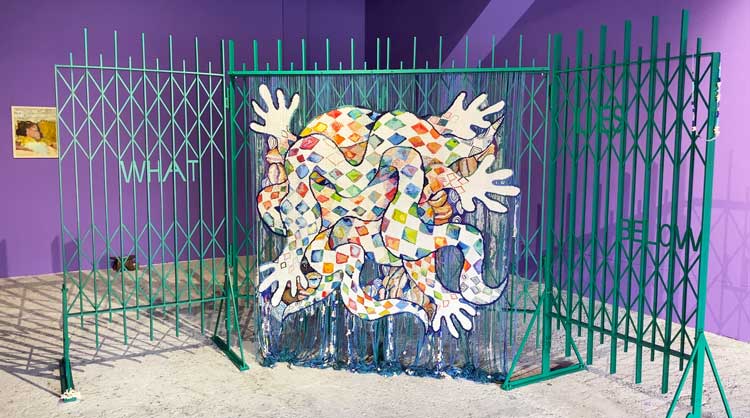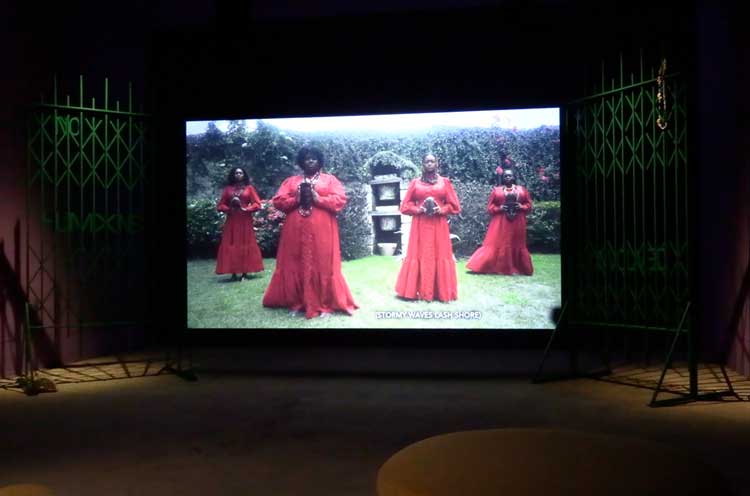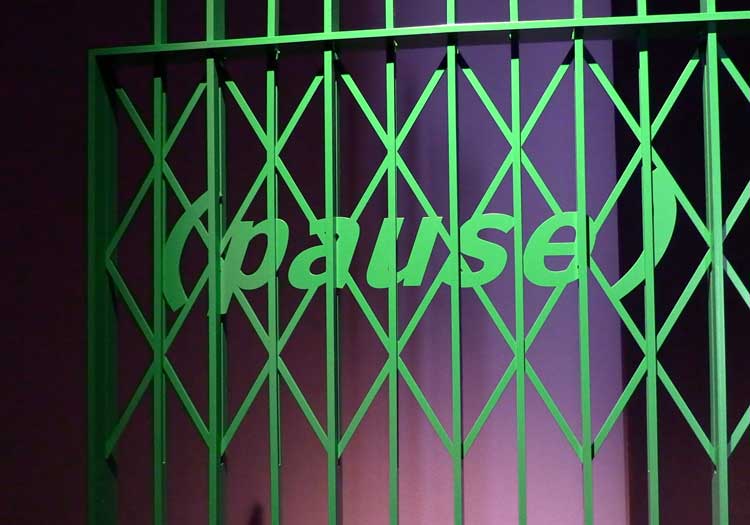Set apart from the crush and crowds of the nearby biennale venues, in a former boatyard, on a tranquil, waterfront site, the work by Alberta Whittle (b1980 Bridgetown, Barbados), for Scotland in Venice, invites you to do as its title says: pause. Her installation, Deep Dive (Pause) Uncoiling Memory, comprises tapestry, film and sculpture, and revisits and enriches themes Whittle has explored before: colonialism, oppression, forgotten (or suppressed) histories, the many legacies of slavery, and the experience of racism.

Alberta Whittle: Deep Dive (Pause) Uncoiling Memory, installation view, Scotland + Venice, 2022. Photo: Martin Kennedy.
For Venice, it is the core part of her practice, the idea of collective care as an antidote to “anti-blackness”, that comes across most powerfully – in the seating and blankets she places around the two-room space to allow for rumination and discussion, as much as in the evident time, energy and love she has expended in making these works, alongside a variety of collaborators.

Alberta Whittle: Deep Dive (Pause) Uncoiling Memory, installation view, Scotland + Venice, 2022. Photo: Martin Kennedy.
And despite the work’s unflinching exposure of issues that damage us all, this enveloping sense of compassion, clarity and affection emanates from the work and gives one the feeling that her mission, as explained in the introductory panel to her Venice installation, could be accomplished: “To collectively consider the historic legacies and contemporary expressions of racism, colonialism and migration, and begin to think outside these damaging frameworks.”

Alberta Whittle: Deep Dive (Pause) Uncoiling Memory, Scotland + Venice, 2022. Photo: Martin Kennedy.
There are big green gates – vivid against the bright-purple-painted walls of the first gallery - placed at the waterfront, and around the two rooms within this former boat shed, which bear key words, including Remember, Pause, Breathe. One has pale lilac and maroon glass – made here in Venice – inserted into its frame.

Alberta Whittle: Deep Dive (Pause) Uncoiling Memory, installation view, Scotland + Venice, 2022. Photo: Martin Kennedy.
Another is draped with a tapestry, of writhing limbs, splayed hands and snakes, which Whittle made at Edinburgh’s Dovecot Studios, with the words “what lies below” inserted into the metal frame. These snakes and tangled hands, says Whittle: “Are a way of thinking about the acquisitiveness of empire. The hands are made from a donation of whale ropes.” Caribbean cowrie shells are arranged around the foot of a gate, to evoke the ancient forms of trading that presaged colonial expansion, slavery and oppression.

Alberta Whittle: Deep Dive (Pause) Uncoiling Memory, installation view, Scotland + Venice, 2022. Photo: Martin Kennedy.
The commission expands her opportunities to explore her core theme, which she states as: “How do we look at history and its impact on the everyday? I was thinking about this work as an excavation … into histories. But also … a way of thinking about what does it mean to build community and think of new strategies of being together. A call to change: that’s really my hope for the exhibition.”
In 2021, Whittle was in solo presentations at Jupiter Artland in Edinburgh, the Liverpool Biennial, Art Night London and Glasgow International and she was in the group show Life Between Islands: Caribbean British Art 1950s to Now, at Tate Britain. In 2020, she was awarded a Turner Bursary, a Frieze Artist Award and a Henry Moore Foundation Artist Award. She had a solo exhibition at Dundee Contemporary Arts in 2019.
Forthcoming exhibitions include a group show at Fotografiska, New York and a solo show as part of the British Art Show 9 in Plymouth. The Venice work will appear as part of a larger show of her work at the Scottish National Gallery of Modern Art, Edinburgh.
Alberta Whittle: Deep Dive (Pause) Uncoiling Memory
Scotland in Venice, Docks Cantieri Cucchini, S Pietro di Castello 40, Venice
23 April – 27 November 2022
Interview by VERONICA SIMPSON
Filmed by MARTIN KENNEDY
William Kentridge: The Pull of Gravity
The first UK institutional show dedicated to William Kentridge’s sculpture is joyfully approachabl...
Guy Oliver’s laugh-out-loud film about being a teenager, Aqsa Arifa’s exploration of life as a r...
Making Waves – Breaking Ground
With 11 artists and more than 100 works, the wonders of the natural world are stunningly brought to ...
A thoughtfully curated exploration of the convergence of art and health in the work of Munch, a man ...
Pablo Picasso: The Code of Painting
This show draws international attention to a vibrant new art space in the Norwegian city of Trondhei...
Ro Robertson – interview: ‘The female shipbuilders of Sunderland have ...
At Sunderland’s Northern Gallery for Contemporary Art, which stands beside the River Wear, is a ne...
Border Crossings: Ten Scottish Masters of Modern Art
This show pays homage to the remarkable legacy of 10 artists who left their Scottish homeland to ach...
Niki de Saint Phalle & Jean Tinguely: Myths and Machines
She was an aristocrat sculpting voluptuous female figures, he a working-class maker of scrap metal k...
Natalia Millman – interview: ‘I want to talk about grief in an approac...
Inviting others to write a letter about their grief, and responding to each with a drawing, was the ...
A fine-tuned pocket survey celebrates the influential French realist painter, who imbued scenes of r...
Ernest Edmonds – interview: ‘The technology didn’t make it easy at t...
On the occasion of Networked, his show at Gazelli Art House, London, the pioneering computer artist ...
For Children: Art Stories since 1968
A skating ramp, an invitation to paint the floor, a glowing tent-like structure – this ambitious j...
Ten Sculptures by Tim Scott 1961-71– book review
A thorough introduction to and overview of a fascinating artist who has been far too overlooked. The...
Folkestone Triennial 2025: How Lies the Land?
Sorcha Carey’s first outing as curator of the Folkestone Triennial turns its sixth iteration into ...
New paintings by American artist, Pat Steir, now 87, make their debut in this exhibition in Zurich...
Lubaina Himid with Magda Stawarska: Another Chance Encounter
Drawing on correspondence between the writer Sophie Brzeska and the artist Nina Hamnett as well as H...
Collaborating with craftspeople from around the world, Seulgi Lee incorporates traditional technique...
Mika Rottenberg – interview: ‘I’m not an angel or a political activi...
The multidisciplinary artist Mika Rottenberg talks about her first solo exhibition in Spain, at Haus...
Berlin. Cosmopolitan: The Vanished World of Felicie and Carl Bernstein
This small but insightful show puts the spotlight on a microcosm within Berlin’s art world at the ...
Emma Talbot – interview: ‘I imagine the experience of life as an epic...
Large installations, paintings on silk, fabric sculptures and drawings convey the connection between...
To mark its 40th birthday, Ditchling Museum of Art + Craft is hosting an exhibition all about reachi...
Mike Nelson: Humpty Dumpty, a transient history of Mardin earthworks low r...
From the architecture of an old hilltop city in Turkey to the demolished Heygate Estate in south Lon...
Jenny Saville: The Anatomy of Painting
Jenny Saville: This astounding show brings together the very best of an incomparable artist: absorbi...
From a mother bathing her children to cleaners working at the gallery, Margaret Salmon gives voice t...
Slavs and Tatars: The Contest of the Fruits
Rapping fruit, legendary birds and nail art feature in the UK debut of the Berlin-based collective S...
Liverpool Biennial 2025: Bedrock
From Sheila Hicks’s gemstone-like sculptures to Elizabeth Price’s video essay on modernist Catho...
Mikhail Karikis – interview: ‘What is the soundscape of the forthcomin...
Mikhail Karikis explains the ideas behind his new sound and video installation calling for action ag...
Art & the Book* and Spineless Wonders: The Power of Print Unbound**
Two concurrent exhibitions bring special collections into broader spaces of circulation, highlightin...
Focusing on the skills of wallpaper design and embroidery, this exhibition tells the story of the ...
Daphne Wright: Deep-Rooted Things
This show is a celebration of the domestic, and the poignant sculpture of Wright’s two sons, now o...